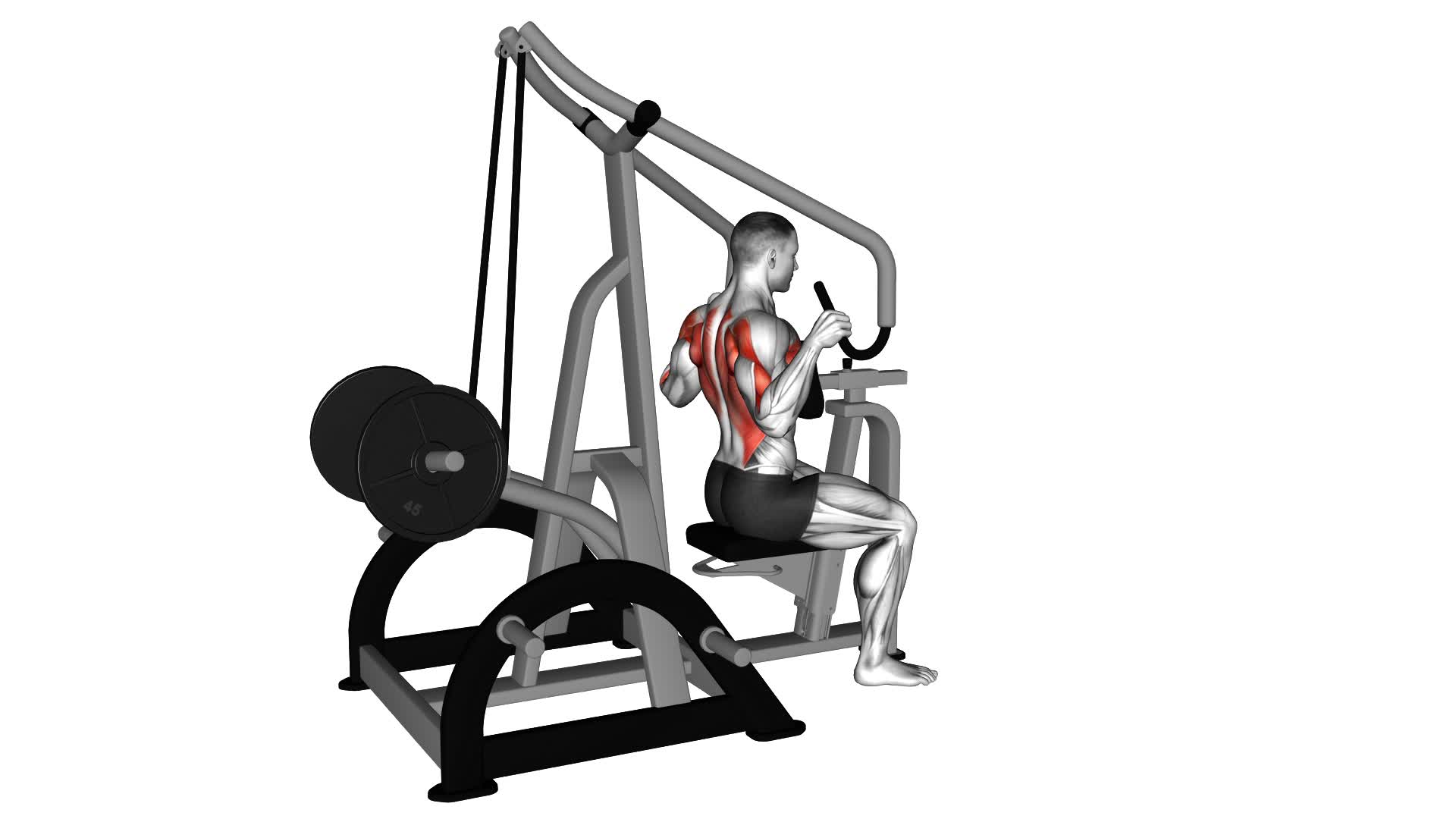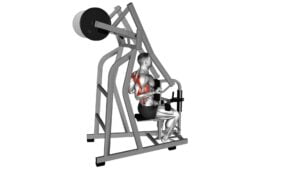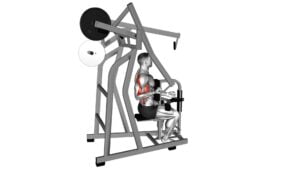Lever High Row (Plate Loaded) (Version 3) – Video Exercise Guide & Tips

Are you looking to strengthen your upper back and shoulders? Look no further than the Lever High Row (Plate Loaded) exercise.
Watch This Exercise Video
In this comprehensive video exercise guide, we'll walk you through the proper form and technique, as well as variations and modifications to suit your fitness level.
With its numerous benefits and tips for maximizing your workout, incorporating the Lever High Row into your routine is a surefire way to achieve a stronger, more defined upper body.
Key Takeaways
- Lever High Row is a plate loaded exercise that strengthens the upper back and shoulders.
- Proper form and technique, such as maintaining a neutral spine, engaging core muscles, and pulling with the elbows, are crucial for this exercise.
- Variations and modifications, such as wide grip or reverse grip variations, increasing weight or repetitions, and performing unilaterally, can add challenge and variety to the exercise.
- Incorporating Lever High Row into a workout routine can improve back strength and posture, enhance pulling power, and provide emotional benefits such as increased confidence and reduced stress.
Overview of the Lever High Row Exercise
To perform the Lever High Row exercise, position yourself on the machine with your feet firmly planted on the ground and grasp the handles with an overhand grip. This exercise is an effective way to target your upper back muscles and improve your posture. Proper technique is crucial to maximize the benefits and avoid injury.
Make sure to adjust the seat height so that your arms are fully extended when gripping the handles. Keep your back straight and core engaged throughout the movement. As you pull the handles towards your chest, focus on squeezing your shoulder blades together. Maintain a controlled motion and avoid using momentum to complete the exercise.
It's important to use the appropriate equipment for this exercise. The Lever High Row machine is specifically designed to target your upper back muscles, providing a safe and effective workout. Now that you're familiar with the proper technique and equipment needed for the Lever High Row exercise, let's move on to the next section to discuss proper form and technique in more detail.
Proper Form and Technique for Lever High Row
Now let's delve into the proper form and technique for the Lever High Row exercise, building upon the information discussed in the previous section. Mastering the proper technique is crucial to maximizing muscle activation and reaping the full benefits of this exercise. Here are some key points to keep in mind:
- Maintain a neutral spine: Keep your back straight throughout the movement and avoid rounding or arching your back. This ensures proper alignment and reduces the risk of injury.
- Engage your core: Brace your core muscles by drawing your belly button in towards your spine. This helps stabilize your torso and protects your lower back.
- Retract your shoulder blades: Start the movement by squeezing your shoulder blades together. This activates the muscles of your upper back and promotes proper posture.
- Pull with your elbows: Instead of using your hands or arms to pull the weight, focus on initiating the movement with your elbows. This helps target the muscles in your upper back more effectively.
- Control the weight: Avoid using momentum or jerking motions. Instead, focus on a slow and controlled movement throughout the exercise.
Variations and Modifications for Lever High Row
Continue exploring the Lever High Row exercise with variations and modifications that can enhance your workout and target specific muscle groups. By incorporating different variations and modifications into your routine, you can challenge your muscles in new ways and prevent plateaus in your progress.
One variation of the Lever High Row is the wide grip variation. Instead of using a shoulder-width grip, widen your grip by placing your hands wider apart on the handles. This variation targets the outer muscles of your back, specifically the latissimus dorsi.
Another variation is the reverse grip variation. Instead of using an overhand grip, use an underhand grip with your palms facing up. This variation places more emphasis on your biceps and forearms while still engaging the muscles in your back.
To modify the exercise and make it more challenging, you can increase the weight or the number of repetitions. You can also perform the exercise unilaterally by using one arm at a time, which increases the demand on your core muscles for stability.
Remember to always maintain proper form and technique, regardless of the variation or modification you choose. Start with lighter weights and gradually increase the intensity as you become more comfortable and confident with the exercise.
Incorporating variations and modifications into your Lever High Row routine can help you target specific muscle groups and keep your workouts interesting and effective.
Benefits of Incorporating Lever High Row Into Your Workout Routine
Incorporating Lever High Row into your workout routine offers several benefits.
First, it helps improve back strength by targeting the muscles in your upper back and shoulders.
This exercise also enhances your pulling power, making it easier to perform other pulling movements in your workouts.
Improved Back Strength
To enhance your back strength, you can achieve significant benefits by including the Lever High Row exercise in your workout routine. This exercise not only targets your back muscles but also helps improve your posture and prevent injuries.
Incorporating Lever High Row into your workout routine can have the following emotional benefits:
- Increased confidence: As your back strength improves, you'll feel more confident in your overall physical abilities.
- Reduced stress: Engaging in regular exercise, like Lever High Row, can help reduce stress levels and promote a sense of well-being.
- Enhanced body awareness: By focusing on your back muscles during this exercise, you'll develop a greater understanding of your body and its capabilities.
Targeted Upper Body Muscles
You should regularly include the Lever High Row exercise in your workout routine to effectively target and strengthen your upper body muscles. This exercise specifically focuses on your back muscles, including the latissimus dorsi, rhomboids, and trapezius.
By incorporating the Lever High Row into your routine, you can improve your posture and build a strong back. Strong back muscles are essential for maintaining good posture, as they help support the spine and keep it aligned properly.
Additionally, a strong back can help with other exercises that require pulling movements, such as pull-ups or deadlifts. By strengthening your upper body muscles with the Lever High Row, you can increase your pulling power and improve your overall strength and fitness.
Increased Pulling Power
Regularly including the Lever High Row exercise in your workout routine will significantly increase your pulling power. This exercise specifically targets your back muscles, helping you develop increased strength and overall back training. By incorporating Lever High Rows into your workouts, you can expect the following benefits:
- Improved posture: Strengthening your back muscles helps maintain proper alignment and reduces the risk of slouching or hunching over.
- Increased functional strength: Pulling motions are essential in everyday activities such as lifting, carrying, and pulling objects. Enhancing your pulling power through Lever High Rows can make these tasks easier and more efficient.
- Enhanced athletic performance: A stronger back translates into improved performance in sports and physical activities that require pulling or gripping, such as rock climbing, rowing, or wrestling.
Common Mistakes to Avoid When Performing Lever High Row
Avoiding common mistakes is crucial when performing the Lever High Row exercise. By understanding and avoiding these common misconceptions, you can ensure that you perform the exercise correctly and effectively, while minimizing the risk of injuries.
One common mistake to avoid is using too much weight. While it may be tempting to load up the machine with heavy plates, using excessive weight can compromise your form and increase the risk of straining your muscles or injuring your back. Remember to start with a weight that allows you to maintain proper form throughout the exercise.
Another mistake to avoid is using improper technique. It's important to maintain a neutral spine throughout the movement and avoid rounding your back. Engage your core muscles and keep your shoulders down and relaxed. Focus on pulling with your back muscles rather than relying on your arms or shoulders to do the work.
Lastly, it's important to avoid jerking or using momentum to perform the exercise. The Lever High Row should be performed in a controlled manner, with smooth and deliberate movements. This will ensure that you target the intended muscles and avoid unnecessary strain on your joints.
Tips for Getting the Most Out of Your Lever High Row Workout
To get the most out of your Lever High Row workout, it's important to focus on proper form. This means maintaining a straight back and engaging your core.
You should also focus on pulling with your shoulder blades, rather than using momentum. This will help you target the muscles more effectively and prevent injury.
In addition to maintaining proper form, varying the resistance levels by adjusting the weight plates will help challenge your muscles and promote strength gains.
Lastly, to target specific muscle groups, consider adjusting your grip width and hand position during the exercise. This will allow you to work different parts of your back and arms.
Proper Form Importance
To maximize the benefits of your Lever High Row workout, focus on maintaining proper form throughout the exercise. Keeping the correct form not only ensures that you're targeting the intended muscles but also helps prevent injuries. Here are some key tips to help you maintain proper form and get the most out of your Lever High Row workout:
- Keep your back straight and shoulders down to engage your upper back muscles effectively.
- Avoid using momentum or swinging your body to lift the weight, as this can put unnecessary strain on your lower back.
- Maintain a controlled and smooth movement throughout the exercise, focusing on squeezing your shoulder blades together at the top of the movement.
Varying Resistance Levels
To maximize the benefits of your Lever High Row workout and get the most out of varying resistance levels, focus on adjusting the weight according to your strength and fitness goals.
Resistance levels play a crucial role in developing strength and muscle growth. The principle of progressive overload suggests that you need to gradually increase the resistance over time to continue challenging your muscles and stimulate growth.
Start with a weight that allows you to perform the exercise with proper form and control. As you get stronger, gradually increase the resistance to keep progressing. Aim for a weight that allows you to complete the desired number of reps with proper form but still feels challenging.
Targeting Specific Muscle Groups
To target specific muscle groups and get the most out of your Lever High Row workout, focus on engaging the muscles in your back and arms by pulling the weight towards your chest in a controlled motion. This exercise is great for muscle activation in the upper body and can be further enhanced with exercise progression.
Here are three tips to help you maximize your workout and achieve optimal results:
- Gradually increase the weight: As your muscles adapt and become stronger, progressively increase the resistance to continue challenging them and promoting muscle growth.
- Vary your grip: Experiment with different grip positions, such as wide or narrow, to target different areas of your back and arms.
- Focus on technique: Maintain proper form throughout the exercise, keeping your back straight and shoulders pulled back. This will ensure that you're effectively targeting the desired muscle groups and minimizing the risk of injury.
Frequently Asked Questions
How Much Weight Should I Use for the Lever High Row Exercise?
When performing the lever high row exercise, it's important to choose the appropriate weight for your fitness level and goals. Start with a weight that challenges you, but allows you to maintain proper form and technique.
Focus on using correct posture, engaging your back muscles, and avoiding common mistakes like rounding your shoulders or using momentum. By using the right amount of weight and practicing good form, you can maximize the effectiveness of the lever high row exercise.
How Many Sets and Repetitions Should I Do for the Lever High Row Exercise?
To determine the number of sets and repetitions for the lever high row exercise, consider your fitness level and goals. Generally, aim for 3-4 sets of 8-12 reps with proper form. This will help build strength and muscle endurance.
Remember to use a weight that challenges you but allows you to maintain proper form throughout the exercise. Adjust the weight or reps as needed to continue progressing and avoid plateaus.
Can I Perform the Lever High Row Exercise With a Resistance Band Instead of a Plate Loaded Machine?
Yes, you can perform the lever high row exercise with a resistance band instead of a plate loaded machine. Using a resistance band as an alternative can provide similar benefits to the lever high row exercise.
It allows you to target your upper back muscles, improve your posture, and strengthen your arms and shoulders.
The resistance band also offers the advantage of being portable and convenient, making it a versatile option for home or travel workouts.
Is It Necessary to Warm up Before Starting the Lever High Row Exercise?
Before starting the lever high row exercise, it's necessary to warm up. Warming up has several benefits, such as increasing blood flow to the muscles, improving flexibility, and reducing the risk of injury.
It prepares your body for the upcoming workout and helps you perform better. If you don't have access to the specific equipment required for the lever high row, there are alternative exercises you can do to target the same muscle groups.
Can the Lever High Row Exercise Help Improve Posture?
Incorporating the lever high row exercise into your workout routine can benefit your posture. It targets the muscles in your upper back and shoulders, helping to strengthen them and improve your overall posture.
However, it's important to avoid common mistakes while performing this exercise, such as using too much weight or rounding your back. By practicing proper form and gradually increasing the weight, you can maximize the benefits of the lever high row for your posture.
Conclusion
Incorporating the lever high row exercise into your workout routine can offer numerous benefits. It targets the upper back muscles, improves posture, and enhances overall strength.
By maintaining proper form and avoiding common mistakes, you can maximize the effectiveness of this exercise. Remember to vary the resistance and try different variations to challenge your muscles.
With consistent effort, the lever high row can help you achieve your fitness goals and promote a strong and balanced physique.

Author
Years ago, the spark of my life’s passion ignited in my mind the moment I stepped into the local gym for the first time. The inaugural bead of perspiration, the initial endeavor, the very first surge of endorphins, and a sense of pride that washed over me post-workout marked the beginning of my deep-seated interest in strength sports, fitness, and sports nutrition. This very curiosity blossomed rapidly into a profound fascination, propelling me to earn a Master’s degree in Physical Education from the Academy of Physical Education in Krakow, followed by a Sports Manager diploma from the Jagiellonian University. My journey of growth led me to gain more specialized qualifications, such as being a certified personal trainer with a focus on sports dietetics, a lifeguard, and an instructor for wellness and corrective gymnastics. Theoretical knowledge paired seamlessly with practical experience, reinforcing my belief that the transformation of individuals under my guidance was also a reflection of my personal growth. This belief holds true even today. Each day, I strive to push the boundaries and explore new realms. These realms gently elevate me to greater heights. The unique combination of passion for my field and the continuous quest for growth fuels my drive to break new ground.







